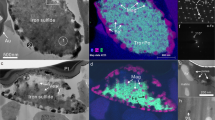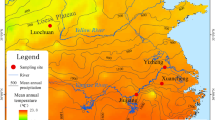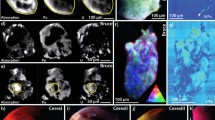Abstract
Abundant nanophase iron (np-Fe0) is ubiquitously formed on the surface of the Moon and other airless bodies through space weathering processes, and plays a dominant role in transforming the optical properties of the lunar surface. The main sources of np-Fe0 are usually considered to be evaporative deposition or ion-reduction processes. Here we show that disproportionation reactions triggered by micrometeorite impacts can be the main contributor to np-Fe0 formation. We measured the valence states of iron in the microcraters on a fine-grained Chang’e-5 sample (number CE5C0200YJFM00302) and found the presence of np-Fe0 and associated Fe3+ in the amorphous mixture of olivine, which can be explained by the disproportionation reaction of Fe2+ during microimpacts. The chemical composition of the residual impactor suggested that it was formed by a secondary low-velocity impact on lunar anorthite. As the whole process was dominated by impact events without the contribution from the solar wind, these findings inform us on weathering mechanisms on regions or bodies that do not experience a strong solar wind component, such as permanently shadowed areas or outer Solar System bodies.
This is a preview of subscription content, access via your institution
Access options
Access Nature and 54 other Nature Portfolio journals
Get Nature+, our best-value online-access subscription
$29.99 / 30 days
cancel any time
Subscribe to this journal
Receive 12 digital issues and online access to articles
$119.00 per year
only $9.92 per issue
Buy this article
- Purchase on Springer Link
- Instant access to full article PDF
Prices may be subject to local taxes which are calculated during checkout





Similar content being viewed by others
Data availability
All data generated and analysed in this study are included in the article and its Supplementary Information. A complete dataset for this study is also available at Mendeley Data at https://doi.org/10.17632/sy4g3mg8j2.1. Source data are provided with this paper.
References
Pieters, C. M. & Noble, S. K. Space weathering on airless bodies. J. Geophys. Res. Planets 121, 1865–1884 (2016).
Sasaki, S., Nakamura, K., Hamabe, Y., Kurahashi, E. & Hiroi, T. Production of iron nanoparticles by laser irradiation in a simulation of lunar-like space weathering. Nature 410, 555–557 (2001).
Hapke, B. Space weathering from Mercury to the asteroid belt. J. Geophys. Res. Planets 106, 10039–10073 (2001).
Anand, M. et al. Space weathering on airless planetary bodies: clues from the lunar mineral hapkeite. Proc. Natl Acad. Sci. USA 101, 6847–6851 (2004).
Noguchi, T. et al. Incipient space weathering observed on the surface of Itokawa dust particles. Science 333, 1121–1125 (2011).
Ryan, E. V. Asteroid fragmentation and evolution of asteroids. Annu. Rev. Earth Planet. Sci. 28, 367–389 (2000).
Binzel, R. P. et al. Earth encounters as the origin of fresh surfaces on near-Earth asteroids. Nature 463, 331–334 (2010).
Dai, Z. et al. Possible in situ formation of meteoritic nanodiamonds in the early solar system. Nature 418, 157–159 (2002).
Pieters, C. et al. Distinctive space weathering on Vesta from regolith mixing processes. Nature 491, 79–82 (2012).
Vernazza, P. et al. Compositional differences between meteorites and near-Earth asteroids. Nature 454, 858–860 (2008).
Bottke, W. et al. Dating the Moon-forming impact event with asteroidal meteorites. Science 348, 321–323 (2015).
Marchi, S. et al. High-velocity collisions from the lunar cataclysm recorded in asteroidal meteorites. Nat. Geosci. 6, 303–307 (2013).
Vernazza, P., Binzel, R., Rossi, A., Fulchignoni, M. & Birlan, M. Solar wind as the origin of rapid reddening of asteroid surfaces. Nature 458, 993–995 (2009).
Loeffler, M., Dukes, C. & Baragiola, R. Irradiation of olivine by 4 keV He+: simulation of space weathering by the solar wind. J. Geophys. Res. Planets 114, E03003 (2009).
Dukes, C., Baragiola, R. & McFadden, L. Surface modification of olivine by H+ and He+ bombardment. J. Geophys. Res. Planets 104, 1865–1872 (1999).
Laczniak, D. et al. Characterizing the spectral, microstructural, and chemical effects of solar wind irradiation on the Murchison carbonaceous chondrite through coordinated analyses. Icarus 364, 114479 (2021).
Fazio, A. et al. Femtosecond laser irradiation of olivine single crystals: experimental simulation of space weathering. Icarus 299, 240–252 (2018).
Thompson, M. S., Zega, T. J., Becerra, P., Keane, J. T. & Byrne, S. The oxidation state of nanophase Fe particles in lunar soil: implications for space weathering. Meteorit. Planet. Sci. 51, 1082–1095 (2016).
Frost, D. J. et al. Experimental evidence for the existence of iron-rich metal in the Earth’s lower mantle. Nature 428, 409–412 (2004).
Guo, Z. et al. Evidence for the disproportionation of iron in a eucrite meteorite: implications for impact processes on Vesta. J. Geophys. Res. Planets 126, E006816 (2021).
Kaluna, H., Ishii, H., Bradley, J., Gillis-Davis, J. & Lucey, P. Simulated space weathering of Fe- and Mg-rich aqueously altered minerals using pulsed laser irradiation. Icarus 292, 245–258 (2017).
Keller, L. P., Berger, E. L., Zhang, S. & Christoffersen, R. Solar energetic particle tracks in lunar samples: a transmission electron microscope calibration and implications for lunar space weathering. Meteorit. Planet. Sci. 56, 1685–1707 (2021).
Li, Q.-L. et al. Two billion-year-old volcanism on the Moon from Chang’e-5 basalts. Nature 600, 54–58 (2021).
Hu, S. et al. A dry lunar mantle reservoir for young mare basalts of Chang’e-5. Nature 600, 49–53 (2021).
Li, C. et al. Characteristics of the lunar samples returned by Chang’e-5 mission. Natl Sci. Rev. 9, nwab188 (2021).
Matsumoto, T., Hasegawa, S., Nakao, S., Sakai, M. & Yurimoto, H. Population characteristics of submicrometer-sized craters on regolith particles from asteroid Itokawa. Icarus 303, 22–33 (2018).
Noble, S., Keller, L., Christoffersen, R. & Rahman, Z. The microstructure of lunar micrometeorite impact craters. In Lunar and Planetary Science and Exploration. No. JSC-CN-35097 (2016).
Thompson, M. S., Christoffersen, R., Zega, T. J. & Keller, L. P. Microchemical and structural evidence for space weathering in soils from asteroid Itokawa. Earth Planets Space 66, 1–10 (2014).
Noguchi, T. et al. Space weathered rims found on the surfaces of the Itokawa dust particles. Meteorit. Planet. Sci. 49, 188–214 (2014).
Spray, J. G. Frictional melting processes in planetary materials: from hypervelocity impact to earthquakes. Annu. Rev. Earth Planet. Sci. 38, 221–254 (2010).
Hörz, F., Hartung, J. & Gault, D. Micrometeorite craters on lunar rock surfaces. J. Geophys. Res. 76, 5770–5798 (1971).
Holsapple, K. A. The scaling of impact processes in planetary sciences. Annu. Rev. Earth Planet. Sci. 21, 333–373 (1993).
Burgess, K. D., Stroud, R. M., Dyar, M. D. & McCanta, M. C. Submicrometer-scale spatial heterogeneity in silicate glasses using aberration-corrected scanning transmission electron microscopy. Am. Mineral. 101, 2677–2688 (2016).
Keller, L. P. & McKay, D. S. Discovery of vapor deposits in the lunar regolith. Science 261, 1305–1307 (1993).
Garvie, L. A. & Buseck, P. R. Ratios of ferrous to ferric iron from nanometre-sized areas in minerals. Nature 396, 667–670 (1998).
Telfer, D. & Walker, G. Optical detection of Fe3+ in lunar plagioclase. Nature 258, 694–695 (1975).
Burgess, K. & Stroud, R. Coordinated nanoscale compositional and oxidation state measurements of lunar space‐weathered material. J. Geophys. Res. Planets 123, 2022–2037 (2018).
Shen, Y., Jester, S. B., Qi, T. & Reed, E. J. Nanosecond homogeneous nucleation and crystal growth in shock-compressed SiO2. Nat. Mater. 15, 60–65 (2016).
Bale, C. W. et al. FactSage thermochemical software and databases. CALPHAD 26, 189–228 (2002).
Bale, C. W. et al. Reprint of: FactSage thermochemical software and databases, 2010–2016. CALPHAD 55, 1–19 (2016).
Cheng, X., Sun, T.-P. & Gordillo, L. Drop impact dynamics: impact force and stress distributions. Annu. Rev. Fluid Mech. 54, 57–81 (2021).
Acknowledgements
We thank CNSA for providing access to the lunar sample CE5C0200YJFM00302. We also thank funding support from Strategic Priority Research Program of the Chinese Academy of Sciences grant XDB 41000000 (Y.L.); Natural Science Foundation of China grant 41931077; and Technical Advanced Research Project of Civil Space grant D020201, Youth Innovation Promotion Association CAS grant 2020395, and Key Research Program of Frontier Sciences, CAS, grant numbers ZDBS-SSW-JSC007-10 and QYZDY-SSW-DQC028 (Y.L.).
Author information
Authors and Affiliations
Contributions
C.L. analysed the datasets and wrote the manuscript. Z.G. contributed to the TEM and EELS discussion. Y.L. contributed to the experimental design and manuscript discussion. K.T., K.W., X.L. J.L. and W.M. contributed to the manuscript discussions.
Corresponding authors
Ethics declarations
Competing interests
The authors declare no competing interests.
Peer review
Peer review information
Nature Astronomy thanks Leon Hicks and Kate Burgess for their contribution to the peer review of this work.
Additional information
Publisher’s note Springer Nature remains neutral with regard to jurisdictional claims in published maps and institutional affiliations.
Supplementary information
Supplementary Information
Supplementary Figs. 1–10 and Table 1.
Source data
Source Data Fig. 1
Unprocessed SEM images for Fig. 1.
Source Data Fig. 2
Unprocessed TEM images for Fig. 2.
Source Data Fig. 3
Unprocessed HAADF and EDS images for Fig. 3.
Source Data Fig. 4
Unprocessed HRTEM and HAADF images and EELS source data for Fig. 4.
Source Data Fig. 5
Source data for Fig. 5.
Rights and permissions
Springer Nature or its licensor (e.g. a society or other partner) holds exclusive rights to this article under a publishing agreement with the author(s) or other rightsholder(s); author self-archiving of the accepted manuscript version of this article is solely governed by the terms of such publishing agreement and applicable law.
About this article
Cite this article
Li, C., Guo, Z., Li, Y. et al. Impact-driven disproportionation origin of nanophase iron particles in Chang’e-5 lunar soil sample. Nat Astron 6, 1156–1162 (2022). https://doi.org/10.1038/s41550-022-01763-3
Received:
Accepted:
Published:
Issue Date:
DOI: https://doi.org/10.1038/s41550-022-01763-3
This article is cited by
-
Measurement of ferric iron in Chang’e-5 impact glass beads
Earth, Planets and Space (2023)
-
Hydrogen-bearing vesicles in space weathered lunar calcium-phosphates
Communications Earth & Environment (2023)



